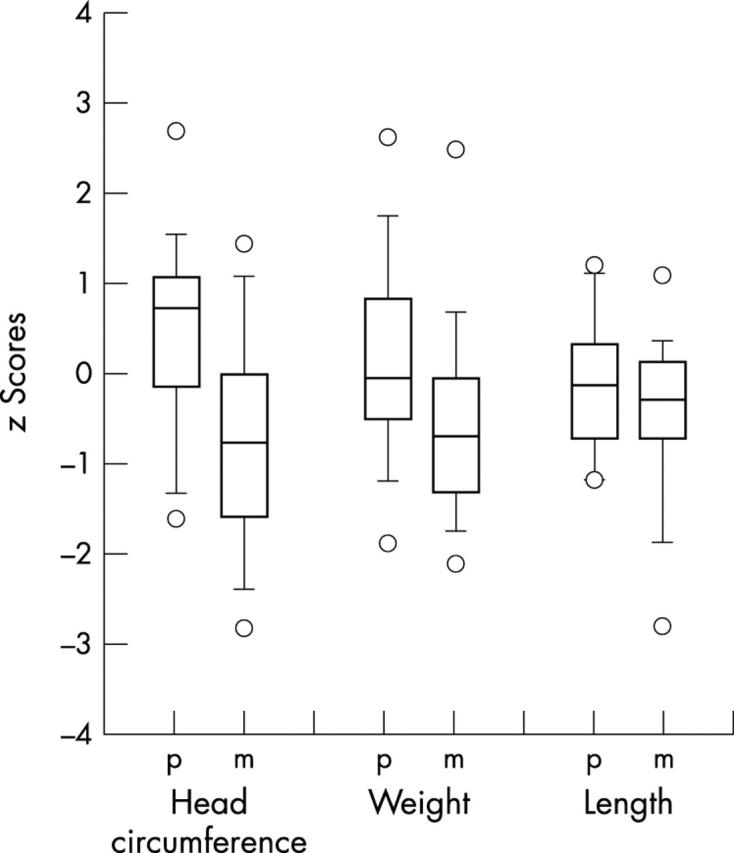Abstract
Objective: To assess the outcomes of infants born to mothers receiving methadone for the management of pain in pregnancy.
Design: A retrospective audit was conducted of neonatal outcomes in 19 cases in which methadone was used in the management of maternal pain (pain group). Twenty four cases in which methadone was used for maintenance of opiate addiction in pregnancy served as a comparison group (maintenance group).
Setting: Regional level 3 neonatal service.
Results: Infants in the pain group were exposed to significantly smaller methadone doses, for shorter periods, starting later in pregnancy. Only 11% of them required treatment for neonatal abstinence syndrome, whereas 58% of infants in the maintenance group required treatment. Other neonatal morbidity in the pain group was considerable, probably related to prematurity. Infants in the pain group had significantly higher z scores for birth weight and head circumference, but not length, than the infants in the maintenance group.
Conclusions: Methadone used for the treatment of maternal pain resulted in a low incidence of neonatal abstinence syndrome. Infants were normally grown. However, there was significant morbidity related to slight prematurity, and delivery in this group should be delayed until term if possible.
Full Text
The Full Text of this article is available as a PDF (166.7 KB).
Figure 1 .

Growth parameters expressed as z scores for infants from pregnancies in which methadone was used for pain (p) or for maintenance of opiate addiction (m). The boxes show 25th–75th centiles, whiskers show 10th–90th centiles, and circles show 5th–95th centiles.
Selected References
These references are in PubMed. This may not be the complete list of references from this article.
- Beeby P. J., Bhutap T., Taylor L. K. New South Wales population-based birthweight percentile charts. J Paediatr Child Health. 1996 Dec;32(6):512–518. doi: 10.1111/j.1440-1754.1996.tb00965.x. [DOI] [PubMed] [Google Scholar]
- Behnke M., Eyler F. D. The consequences of prenatal substance use for the developing fetus, newborn, and young child. Int J Addict. 1993 Nov;28(13):1341–1391. doi: 10.3109/10826089309062191. [DOI] [PubMed] [Google Scholar]
- Coles C. D., Platzman K. A. Behavioral development in children prenatally exposed to drugs and alcohol. Int J Addict. 1993 Nov;28(13):1393–1433. doi: 10.3109/10826089309062192. [DOI] [PubMed] [Google Scholar]
- Doberczak T. M., Kandall S. R., Wilets I. Neonatal opiate abstinence syndrome in term and preterm infants. J Pediatr. 1991 Jun;118(6):933–937. doi: 10.1016/s0022-3476(05)82214-0. [DOI] [PubMed] [Google Scholar]
- Doberczak T. M., Thornton J. C., Bernstein J., Kandall S. R. Impact of maternal drug dependency on birth weight and head circumference of offspring. Am J Dis Child. 1987 Nov;141(11):1163–1167. doi: 10.1001/archpedi.1987.04460110033016. [DOI] [PubMed] [Google Scholar]
- Jacobson B., Nyberg K., Grönbladh L., Eklund G., Bygdeman M., Rydberg U. Opiate addiction in adult offspring through possible imprinting after obstetric treatment. BMJ. 1990 Nov 10;301(6760):1067–1070. doi: 10.1136/bmj.301.6760.1067. [DOI] [PMC free article] [PubMed] [Google Scholar]
- Lifschitz M. H., Wilson G. S., Smith E. O., Desmond M. M. Factors affecting head growth and intellectual function in children of drug addicts. Pediatrics. 1985 Feb;75(2):269–274. [PubMed] [Google Scholar]
- Mack G., Thomas D., Giles W., Buchanan N. Methadone levels and neonatal withdrawal. J Paediatr Child Health. 1991 Apr;27(2):96–100. doi: 10.1111/j.1440-1754.1991.tb00360.x. [DOI] [PubMed] [Google Scholar]
- Suffet F., Brotman R. A comprehensive care program for pregnant addicts: obstetrical, neonatal, and child development outcomes. Int J Addict. 1984 Apr;19(2):199–219. doi: 10.3109/10826088409057176. [DOI] [PubMed] [Google Scholar]
- Zuckerman B., Bresnahan K. Developmental and behavioral consequences of prenatal drug and alcohol exposure. Pediatr Clin North Am. 1991 Dec;38(6):1387–1406. doi: 10.1016/s0031-3955(16)38226-8. [DOI] [PubMed] [Google Scholar]


